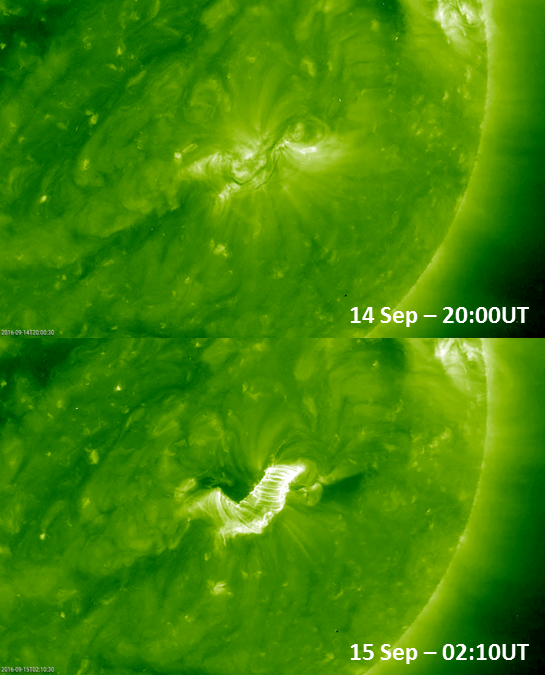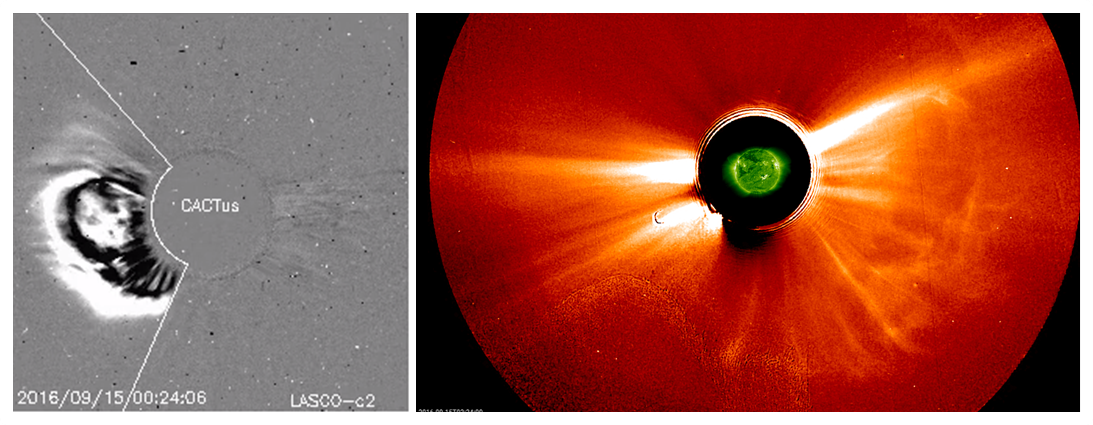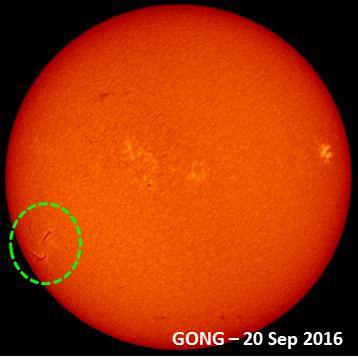For the second consecutive week, no C-class flares were observed from Earth. In fact, not a single C-class flare has been recorded so far this September month, with the last C-class event dating back already from late on 31 August. Records will not be broken soon though, as the longest period without a C-class flare was set during the past solar cycle minimum from 3 April till 3 November 2008 (213 days!).
Fortunately, the Sun's farside displayed a bit more activity, with a strong eruption in old active region NOAA 2580 late on 14 September. NOAA 2580 was a relatively simple sunspot region when it transited the solar disk from 22 August till 2 September, showing already a relatively important group filament visible in dedicated solar filters (GONG; left image). The middle and right images underneath compare the solar disk seen in extreme ultraviolet (EUV) resp. late on 29 August (SDO/AIA 193) and early on 14 September (STEREO-A/EUVI 195). As the solar axis is currently tilted towards the Earth, and STEREO-A (ST-A) being at the farside of the Sun, this spacecraft currently sees a bit more of the southern solar hemisphere making all solar structures shifted towards the north in comparison with imagery from Earth's point of view. Nonetheless, enough solar structures (coronal holes) can be recognized to clearly identify the source of the eruption as old active region NOAA 2580.

Prior to the eruption, the region showed a 15-degrees long S-shaped group filament with another 5-degrees long filament close to the west and in parallel. Starting around 22:30UT on 14 September, the latter violently erupted, being accompanied by a small EUV flare, coronal dimming which was particular strong to the east of the region, and a series of post-eruption coronal loops ("arcade") lasting well into 16 September. See EUV imagery underneath, comparing a pre- (20:00UT) and post-event (02:10UT) image of the blast area.

The EUV imagery also showed a faint coronal wave, somewhat interacting with the coronal holes to the northeast. ST-A's SWAVES instrument captured a strong radio-burst, and the IMPACT instrument recorded a modest 100-fold increase in the 10 MeV particle flux (orange curve). The radio-burst was also detected by the Wind spacecraft, which operates from the L1 Lagrange point 1.5 million km upstream from Earth. The GOES spacecraft, operating from their geostationary orbit about 36.000 km above the Earth's surface, did not detect any enhancement in the greater than 10 MeV proton particle flux.


From the above observations, it was clear that a coronal mass ejection (CME) was associated with this event. This CME was observed by both the SOHO/LASCO instrument as the ST-A/COR instruments. According to CACTus, the CME's plane-of-the-sky speed (as seen from Earth) was near 750 km/s. The ST-A/COR2 instrument observed a partial halo CME, with the bulk of the CME heading to the southwest but also with a clear ST-A directed component. The CME arrived at ST-A about 62 hours later, i.e. shortly after noon on 17 September. Solar wind speed jumped from about 500 km/s to values in the upper 600 km/s, with Bz briefly peaking at a modest -11 nT.

A movie of the aforementioned eruption features can be found here. Meanwhile, the active region has rounded the east limb (as seen from Earth) as a spotless faculae area. Interestingly, the main filament still seems to be present as it was prominently visible in the latest H-alpha imagery from the GONG H-alpha Network. It will be interesting to see if we are in for an "encore performance"...







